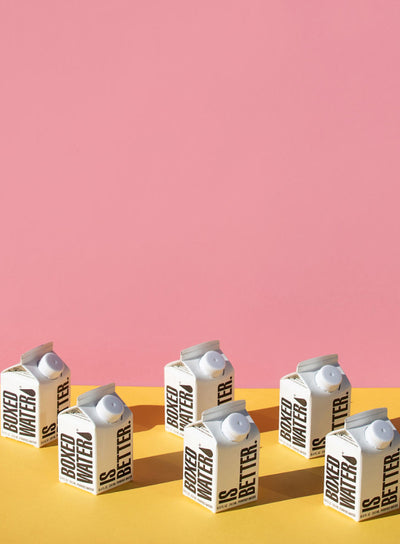You’ve heard of recycling. But what about upcycling?
Recycling is a two-part process: upcycling and downcycling.
Downcycling is what you may be most familiar with. It’s a process that transforms materials into something else, but at a lower quality. For example, plastic is downcycled because plastic fibers lose their strength and quality with use. Plastic can only be recycled once, whereas paper can be recycled up to five times. A plastic bottle might become a garbage bin, but after that it can’t be reused. Unfortunately, the plastic doesn’t just go away. It takes 700 years to break down. Think about it: every piece of plastic that’s EVER been made still exists.
Upcycling is the opposite. It transforms materials into a higher quality product or into a more eco-friendly format. At Boxed Water, recycling is the name and upcycling is the game.

A Better Container
Unlike oil guzzling plastic counterparts, at Boxed Water our boxes are made from a renewable resource that’s all around us: trees. But not just any tree. They’re sourced from well-managed forests. These forests have trees of all different ages, because as trees are processed for paper, pulp and chips, new seedlings are planted to replenish them. This care and thoughtfulness is what makes us eco-friendly from the start, but it doesn’t just stop there.
After your box is used and tossed (correctly) in a recycling bin at schools, parks and stores, that’s where the upcycling process takes over.
There are two ways our boxes are upcycled - either as other paper products or building materials. Being upcycled into paper products occurs when cartons are sent to designated paper mills. They’re combined with water and blended together in a large hydrapulper. Then, the ingredients are carefully separated (paper, plastic and aluminum) and the paper pulp is used to make other paper products while the aluminum and plastic are sent on for further recycling.
We also work with recycling companies like ReWall to turn Boxed Water boxes into building materials. For example, 30 cartons can create a 2-foot by 2-foot ceiling tile. These are manufactured by shredding the cartons and then pressing them together into large sheets with heat.
Sadly, recycling isn’t as prevalent as it should be. According to research, only one in 5 plastic bottles make it to the recycling plant. To put this in perspective, recycling one plastic bottle can save enough energy to power a 60-watt light bulb for six hours.
That’s why we choose paper. It takes less energy to manufacture and recycle than plastic, and its longer lifespan allows us to upcycle our products to make new paper products for years to come.

